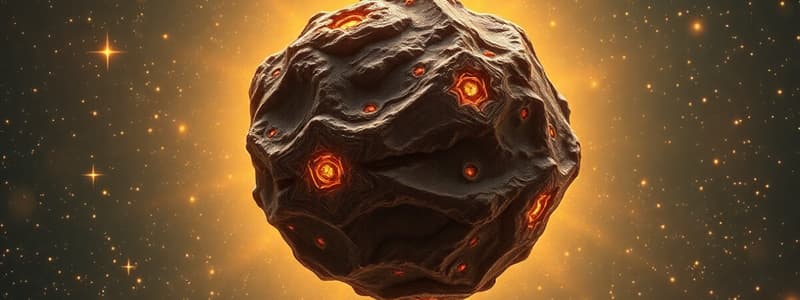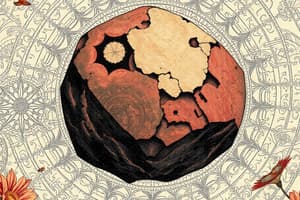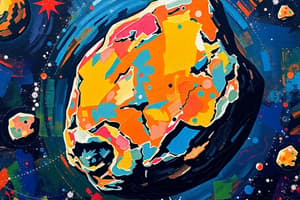Podcast
Questions and Answers
Why is it difficult to accurately determine the size of asteroids using Earth-based telescopes alone?
Why is it difficult to accurately determine the size of asteroids using Earth-based telescopes alone?
Earth's atmosphere bends and distorts the light passing through it, making it difficult to accurately measure the light reflected from an asteroid's surface. This affects size estimations.
How does the James Webb Space Telescope (JWST) improve upon size estimations of asteroids compared to Earth-based telescopes?
How does the James Webb Space Telescope (JWST) improve upon size estimations of asteroids compared to Earth-based telescopes?
The JWST uses infrared sensors to measure the heat radiating off the asteroid, providing a more accurate estimate of its size. This avoids the atmospheric distortions that affect Earth-based telescopes.
What is the primary reason for needing a more accurate size estimate of Asteroid 2024 YR4?
What is the primary reason for needing a more accurate size estimate of Asteroid 2024 YR4?
A more accurate size estimate is needed to determine the potential hazard. The impact of a smaller asteroid (e.g., 40m) is very different compared to a larger one (e.g., 90m).
According to current estimates, the potential impact of Asteroid 2024 YR4 is compared to what historical event?
According to current estimates, the potential impact of Asteroid 2024 YR4 is compared to what historical event?
What is the estimated energy of the explosion if Asteroid 2024 YR4 were to hit Earth?
What is the estimated energy of the explosion if Asteroid 2024 YR4 were to hit Earth?
Why was the James Webb Space Telescope launched into space, as opposed to being stationed on Earth?
Why was the James Webb Space Telescope launched into space, as opposed to being stationed on Earth?
At the time of the report, what is the chance of Asteroid 2024 YR4 impacting Earth in 2032?
At the time of the report, what is the chance of Asteroid 2024 YR4 impacting Earth in 2032?
If the Asteroid 2024 YR4 were to hit Earth, the impact would be how many times more powerful than the atomic bomb dropped on Hiroshima during World War II?
If the Asteroid 2024 YR4 were to hit Earth, the impact would be how many times more powerful than the atomic bomb dropped on Hiroshima during World War II?
Flashcards
Asteroid 2024 YR4
Asteroid 2024 YR4
An asteroid named 2024 YR4 has a 2.3% chance of hitting Earth in 2032.
YR4 Size
YR4 Size
Asteroid 2024 YR4 is approximately 300ft wide, similar in size to the Statue of Liberty or Big Ben.
Estimating Asteroid Size
Estimating Asteroid Size
Measures the light reflected from an asteroid to estimate its size, but is affected by Earth's atmosphere.
James Webb Telescope (JWST)
James Webb Telescope (JWST)
Signup and view all the flashcards
Location of JWST
Location of JWST
Signup and view all the flashcards
Planetary Defense
Planetary Defense
Signup and view all the flashcards
Tunguska Event
Tunguska Event
Signup and view all the flashcards
YR4 Impact Energy
YR4 Impact Energy
Signup and view all the flashcards
Study Notes
- NASA is preparing for a potential impact from Asteroid 2024 YR4, which has a 2.3% chance of hitting Earth in 2032.
- Asteroid 2024 YR4 was discovered in December 2024.
- It is approximately 300ft wide, similar in size to the Statue of Liberty or Big Ben.
- The James Webb Space Telescope (JWST) will be used to study the asteroid and assess the potential damage of an impact.
Potential Impact
- A strike from YR4 is estimated to be comparable to the Tunguska asteroid event of 1908, which flattened 830 square miles of Siberian forest.
- If YR4 were to hit Earth, it could explode with an energy of 15 megatons of TNT. This would produce an explosion 100 times more powerful than the atomic bomb dropped on Hiroshima.
Size Estimation
- Scientists typically estimate asteroid size by measuring the light reflected from its surface using telescopes.
- Larger asteroids generally appear brighter, but atmospheric distortion can affect accuracy.
James Webb Space Telescope Observations
- The James Webb Space Telescope (JWST) is located 1 million miles (1.5 million km) from Earth.
- JWST will use infrared sensors to measure the heat radiating off the asteroid to more accurately estimate its size.
- These improved size estimates are crucial for planetary defense organizations to determine if deflection measures are needed.
Mission Timeframe
- The first JWST observations are scheduled for March, when the asteroid is at its brightest.
- A second observation will occur as the asteroid moves away from the sun.
- There will be no further opportunity to view it until it reappears around 2028.
- Data gathered will be used by ESA, NASA, and other organizations to assess the hazard and plan any necessary responses.
Studying That Suits You
Use AI to generate personalized quizzes and flashcards to suit your learning preferences.
Description
NASA is monitoring Asteroid 2024 YR4, which has a 2.3% chance of impacting Earth in 2032. The asteroid, discovered in December 2024, is about 300ft wide. The James Webb Space Telescope will study the asteroid to assess potential impact damage.




